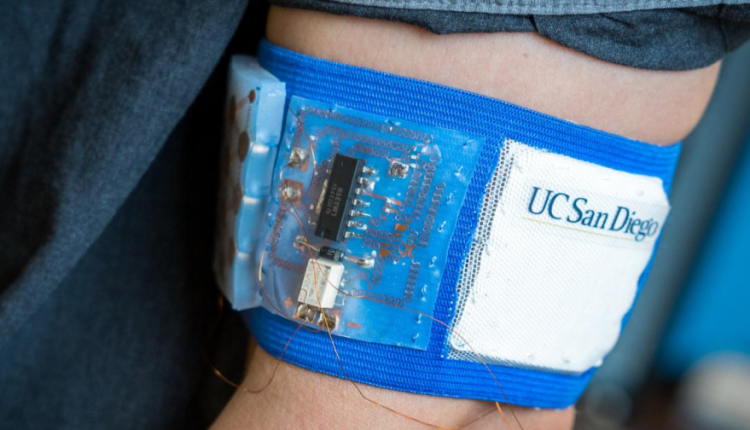
Smart clothing that provides personalized cooling and heating isn’t here yet, but researchers at the UC San Diego Jacobs School of Engineering have created a smart clothing building block, a soft electronic patch that can stretch, bend and twist without compromising its electronic function.
Taking small pillars of thermoelectric materials (made of bismuth telluride alloys), soldering them to thin copper electrode strips, and sandwiching them between two elastomer sheets means the sheets can conduct heat while remaining soft and stretchy. Researchers created the sheets by mixing a rubber material called Ecoflex with aluminum nitride powder, a material with high thermal conductivity.
The patch uses an electric current to move heat from one elastomer sheet to the other. As the current flows across the bismuth telluride pillars, it drives heat along with it, causing one side of the patch to heat up and the other to cool down. A reversible pump permits switching from heating to cooling functions. The patch is powered by a flexible battery pack made of an array of coin cells connected by spring-shaped copper wires and embedded in a stretchable material.
Personalized cooling and heating at home, work, or on the go can not only improve your own comfort, it can help save energy on air conditioning and heating. “If wearing this device can make you feel comfortable within a wider temperature range, you won’t need to turn down the thermostat as much in the summer or crank up the heat as much in the winter,” said Renkun Chen, professor of mechanical and aerospace engineering at UC San Diego, who led the study. Keeping a building’s set temperature 12 degrees higher during the summer, for example, could cut cooling costs by about 70%.
There are a variety of personal cooling and heating devices on the market, but they are not the most convenient to wear or carry around. Some use a fan, and some need to be soaked or filled with fluid such as water. The UC San Diego device is flexible, lightweight, comfortable and convenient to wear, and can easily be integrated into clothing. It physically cools or heats the skin to a temperature the wearer chooses.
The researchers embedded a prototype of the patch into a mesh armband and tested it on a male subject. Tests were performed in a temperature-controlled environment. In two minutes, the patch cooled the tester’s skin to a set temperature of 89.6 degrees Fahrenheit. It kept the tester’s skin at that temperature as the ambient temperature was varied between 71.6 and 96.8 degrees Fahrenheit.
The team estimates it would take 144 patches to create a cooling vest and use about 26 watts total to keep an individual cool on an average hot day (during extreme heat, estimated power use would climb up to 80 watts, which is about how much a laptop uses). By comparison, a conventional air conditioning system uses tens of kilowatts to cool down an entire office.
It’s more energy-efficient to cool down an individual person than a large room, researchers noted. “If there are just a handful of occupants in that room, you are essentially consuming thousands of watts per person for cooling. A device like the patch could drastically cut down on cooling bills,” Chen said.
